Giving Cynara a New Life
The beautiful wooden yacht Cynara has been the symbolic flagship of the Riviera Group, a great treasure that the world has bestowed upon us. Our dream was to launch this boat in a condition as close to the original as possible into the waters of Sagami Bay. We began the restoration project in January, 2017, when Cynara turned 90 years of age
The Survey

Cynara, unlike other surviving yachts of her age in Europe and the Americas, had never undergone a serious restoration, having spent 45 of her 90 years in and around Miura, Japan. In 2014, a plan was first devised to send Cynara to Europe to be restored. Then Riviera Group Chairman Noboru Watanabe decided to investigate the possibility of doing the restoration in Japan.
He invited Paul Harvey and Ben Hobbs, a team of Mallorca-based shipwrights, to come to Japan and conduct a survey and inspection of Cynara’s condition. She was taken to a boatyard in Miura Port and pulled up the slipway for several days while they took notes and photographs of as much as they could see.
On a positive note, the boat was intact, and nothing serious was missing. The results of the survey suggested that large percentages of certain parts of the boat—particularly the deck structures and the more historically valuable parts of the interior—could be reused after restoration. But there were some serious structural issues that would need a more in-depth investigation. The teak of the hull planking looked promising, but access to the frames was limited and fastenings drawn from various hull locations were in poor condition.
While the teak planks seemed firm, it was clear there was some distortion in the hull. Without removing the interior to see the condition of the frames, shelves and beams, how much of the structure could be saved could only be estimated. If the boat were to be restored in Japan, a team of craftsmen would have to be assembled locally and from overseas. Sourcing materials would also be a concern. Purpose-built structures to hold Cynara, and her disassembled parts would have to be constructed on Riviera’s Seabornia Marina site.
A few months later, after studying the shipwrights’ proposal, Mr. Watanabe decided to proceed. It was a momentous decision, as nothing like this had ever been attempted in Japan.
The Team

While Japan’s shipbuilding technology is world-class, it’s a different story when it comes to completely restoring a British wooden sailing ship that was built almost a century ago. Despite the challenges, the decision to keep the project in Riviera’s home port at Seabonia Marina meant inviting engineers and craftsmen specializing in ship restoration from overseas and having them work with local Japanese carpenters. This international cooperation would give the project a more educational aspect, helping pass on the unique techniques and craftsmanship used in building such yachts. Now, we’re proud to say, Riviera Seabonia Marina’s special dock is home to some of the world’s best shipwrights, coming from ten countries all over the world to share their skills.

We are proud to be able to partake in the restoration of Cynara, as it is one of the most prestigious ships we’ve ever worked on. It’s a rare opportunity for craftsmen from Europe to come to the distant land of Japan and work with local engineers to restore a ship. We’re impassioned by Riviera’s ambitious vision, and have been working with the fully motivated staff. There are many differences between the Cynara’s birthplace of the UK and Japan, which add to the challenge. But we can’t forget that the craftsmen who built this ship were also putting their heads and hands together in challenging conditions.
Cynara will once again gracefully traverse the world’s oceans, and we look forward to sharing with Japan the pride and joy that the vessel’s former craftsmen must have felt.
Dismantlement
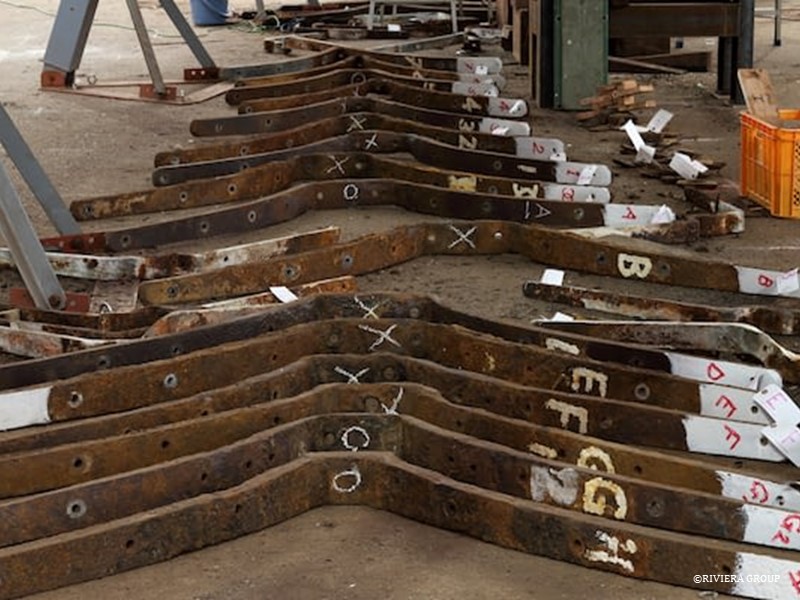
With the boat safely ensconced under a special tent on the dock, the dismantling work on Cynara began in April, 2017. After removing each part one by one, in a very specific order, pieces were marked with tape indicating their order of placement and then stored in racks. The first thing the Japanese staff at the site learned from Master Shipwright, Paul Harvey was to “always remember the four letters: P (Portside), S (Starboard Side), A (Aft), and F (Forward) and write them on every part.” As the work proceeded, the quality of the work by the original shipbuilders 90 years ago became so obvious that their pride and passion was tangible.
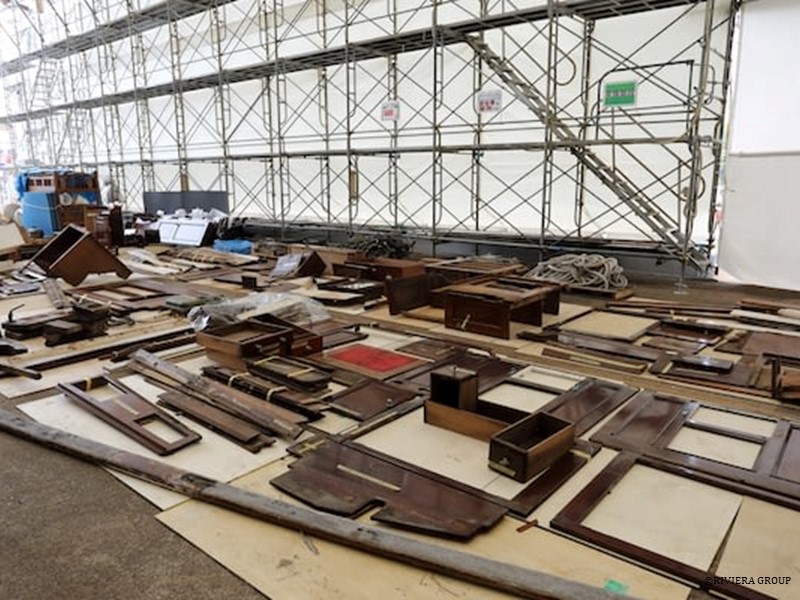
The Keel and Frames
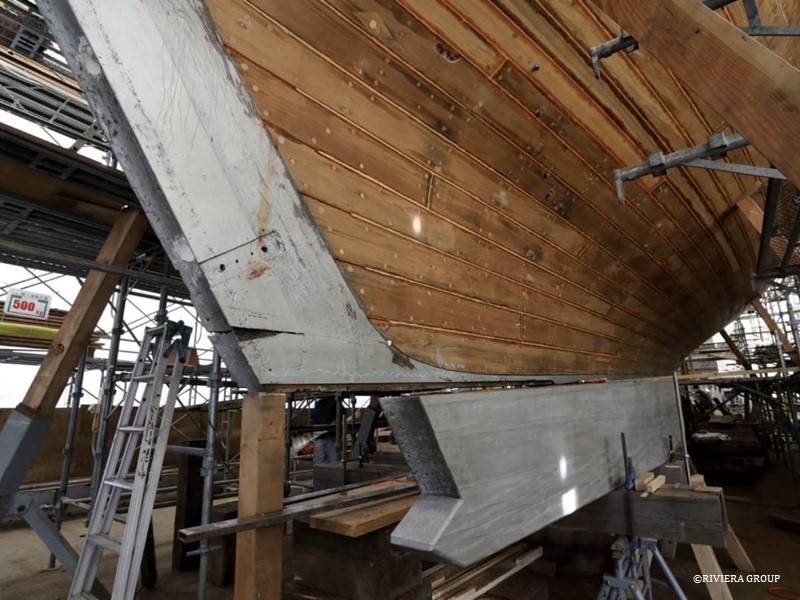
After Cynara was disassembled in the workspace, two large bronze plates of about 3 square meters in area were discovered, a repair job, it seemed, taken after she hit something with her keel ahead of the lead ballast. Clearly needing to take her back to original strength, her frames in this area were replicated with new wrought iron laminated items that were some 50 percent stronger than the originals. In addition the bronze plates were reinstalled, resulting in a very strong structure in this part of the boat, well in excess of the original design. This stage was completed in April 2018.
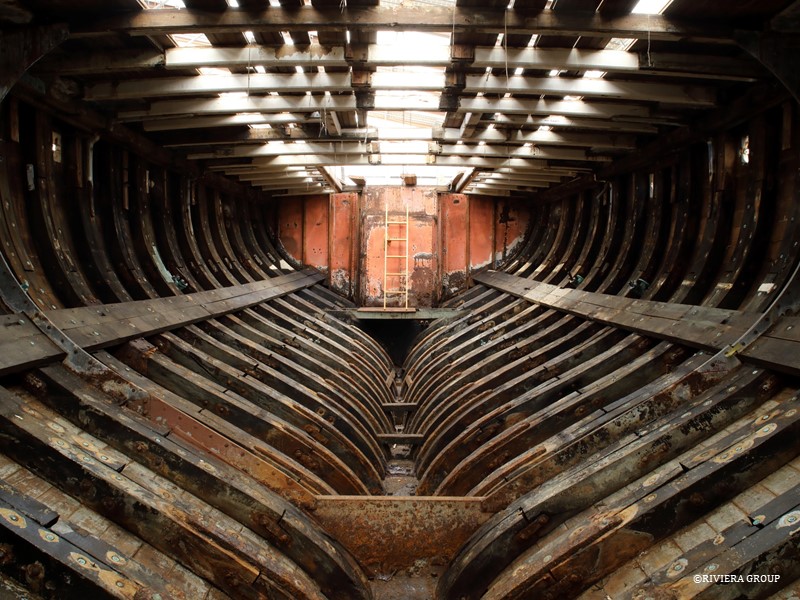
The Hull

Restoration of the hull planking began soon after the dismantling with the removal of paint on the ship’s bottom. Despite the huge task, restoration leaders Paul Harvey and Ben Hobbs banned the use of power tools on this task to avoid damaging the outer planking, and a three-man team did the entire job with hand-held scrapers. The idea to minimize any damage was made knowing how difficult it is to find teak planks of the same length, which pushed the team towards maximum salvation of anything that could be reused.
The hull planking was in good condition, though some of it needed to be replaced. Eventually, however, 92 percent of the original teak planking was salvaged. Finding seven-meter-long planks led to a search of Japanese sawmills far and wide.
Even for experienced craftsman, fitting a new plank is a painstaking and uncompromising experience. After the last plank was finished, which took place on February 2019, our persistent and dedicated documentarian photographer, Yoichi Yabe, was asked to wait until the following day to take a ceremonial photo.

Replacing the Deck
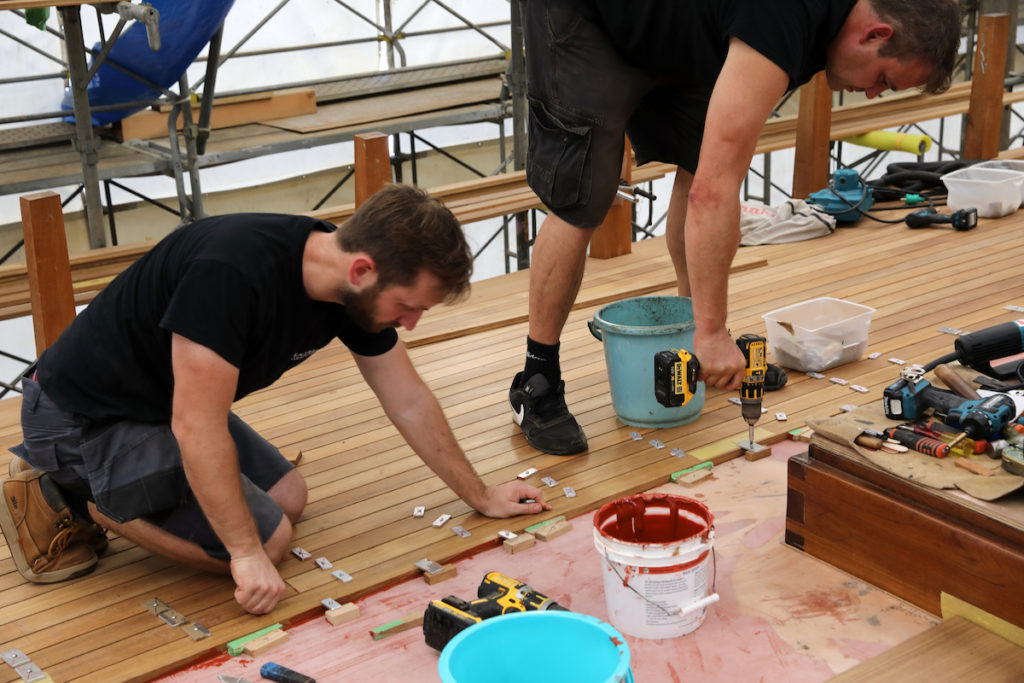
It was obvious from the start that Cynara’s original teak deck would have to be replaced, and work began to remove it in the second half of July, 2017. It was a backbreaking job, especially in the heat of mid-summer. The teak deck was removed in sections. As a traditionally laid deck, the footing was precarious, and safety an issue.
In accordance with the plan to use as much of the original material as possible, some parts of the teak planks that were removed were used to make dowels for use in the restoration. And even though the wood had become dry and grimy, its original brilliance could be restored simply by shaving the surface, proving the strength and flexibility of teak as a valuable to durable.
After much of the structural work on Cynara had been completed, the new teak deck installation was laid between September 13 and October 18, 2019, by six expert shipwrights. The new deck is made up of three layers: a ceiling layer, a layer of plywood, and the top teak surface layer. This design resulted in a deck that is far stronger than the original; it can be easily maintained and, if necessary, restored in the future.
Over the month of installation, the team worked long hours with extraordinary focus and dedication to ensure the deck would meet the high standards of the Cynara restoration.
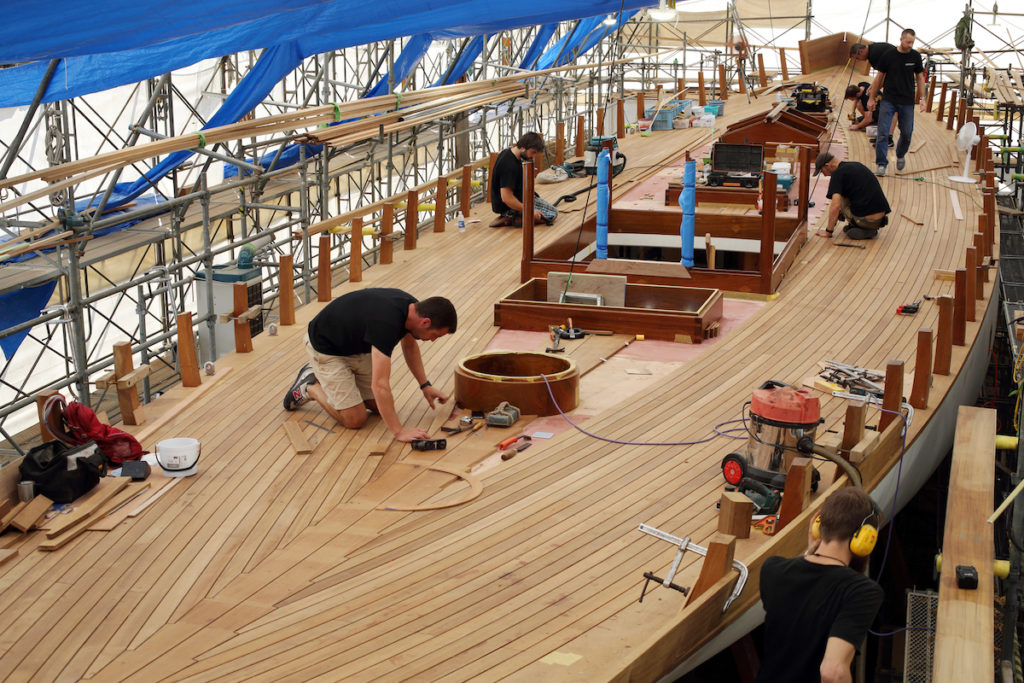
Interior
The original drawings that we received from the UK’s National Maritime Museum portrayed a ship interior that was not too different in style from Cynara’s appearance at the start of the restoration. Of course, there were obvious differences in the cabin layouts, the galley facilities, and other areas. The most striking discovery was that the 1927 plans show a bathroom almost as large as a stateroom, including a bathtub! There were other changes made as technologies and fads changed preferences. Out was the solid-fuel iron stove and its stove pipe, for example. In were 1960’s-era navigation instruments and later, Japanese sinks, taps and toilets.

Luckily for Cynara, most of her major interior repairs, refurbishing, and layout changes over the years were done by Camper and Nicholsons in Gosport, UK, the same shipyard that launched her back in 1927. The work was done in the same style, reflecting the shipyard’s well-known attention to detail and the use of quality materials, from the French polished flame mahogany panels to the hand-made light fittings and switches. The owner therefore decided to retain as much of the interior décor as possible, while making sure the additions followed the original style.
So that’s what was done. The mahogany panels remain, most of them original. Restoration was also done on the many light fixtures, the portholes, the gimbaled base of the saloon table. The new furniture copies the original style, even if the purpose is different. The only difference is the century’s worth of scratches and dents that were left in many of the old pieces to maintain the history and “lived-in” character of a classic yacht.
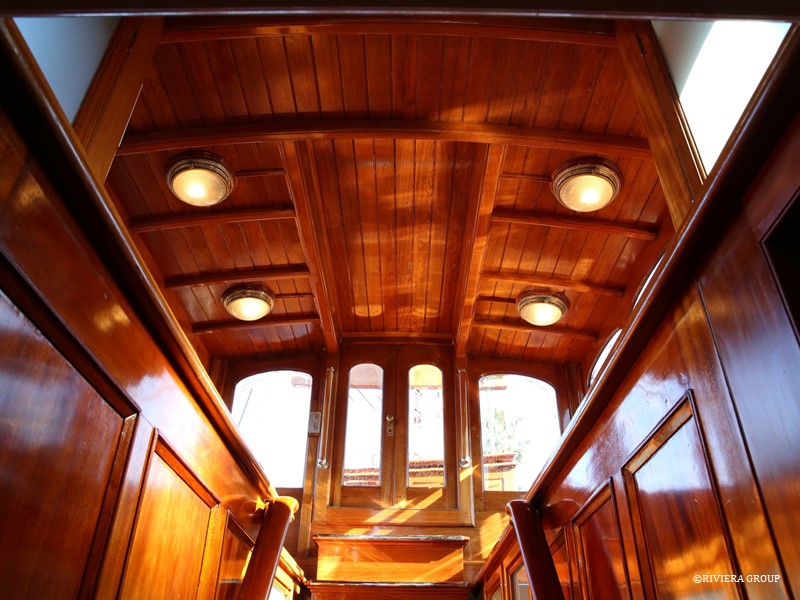
Exterior
Like the interior, it was obvious that the layout and various structures on the deck had gone through changes over the years. Some things had clearly become obsolete, and had been replaced.
The remaining structures on the deck looked reasonable for their age, but there were some telltale signs of trouble. The boat had a pronounced hog, meaning the fore and after ends were sagging, and to fix this was a major priority in the restoration. The hatches and skylights were all looking battered and tired and at first glance possibly irretrievable. But after being dismantled and cleaned, we decided they were worth saving and restoring. Today, all of the hatches, except for the circular sail locker hatch, are restored originals.
Much of the original rigging hardware was iron, and we replaced these with bronze fittings. We restored and reused the bronze fittings that had survived—from the bar cleats and the flagstaff socket to the binnacle and steering mechanism. We found signs that these fittings were nickel plated when they were first made, which would have given the deck of Cynara a “silver” motif. We opted instead to go with a polished bronze finish.
Other changes we’ve made include modern electric winches, bronze hawse pipes and modern life rafts. All in all, the deck now looks very much like it did in 1927, easily recognizable as a Camper and Nicholsons build of the time.
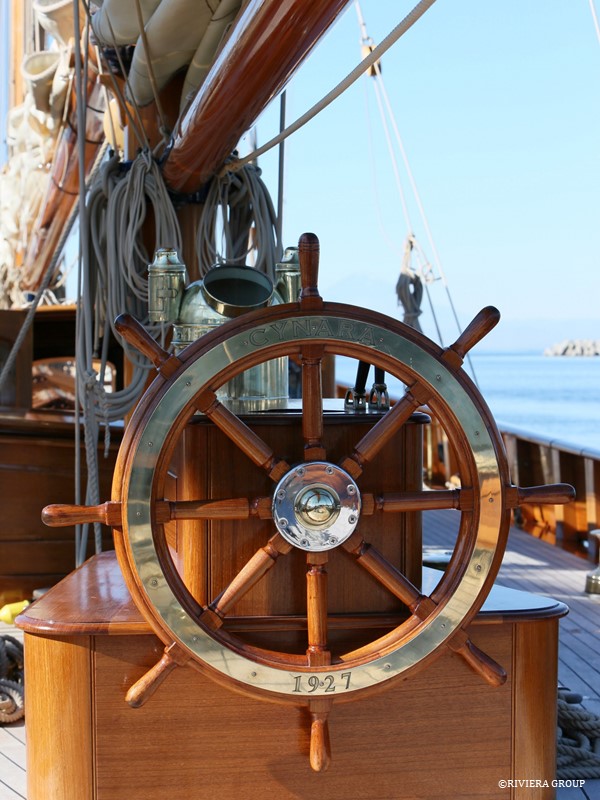
The Masts
It was decided early on that the masts and spars would need replacing, so these were redrawn following the original plans and data taken from the existing spars. Construction of the high-quality masts using Douglas fir was used and the work was entrusted to a team which makes finest wooden mast in the market located in Bristol U.K.
The construction method consisted of arrowhead shaped interlocking wood strips around a hollow core for minimum weight and maximum strength.

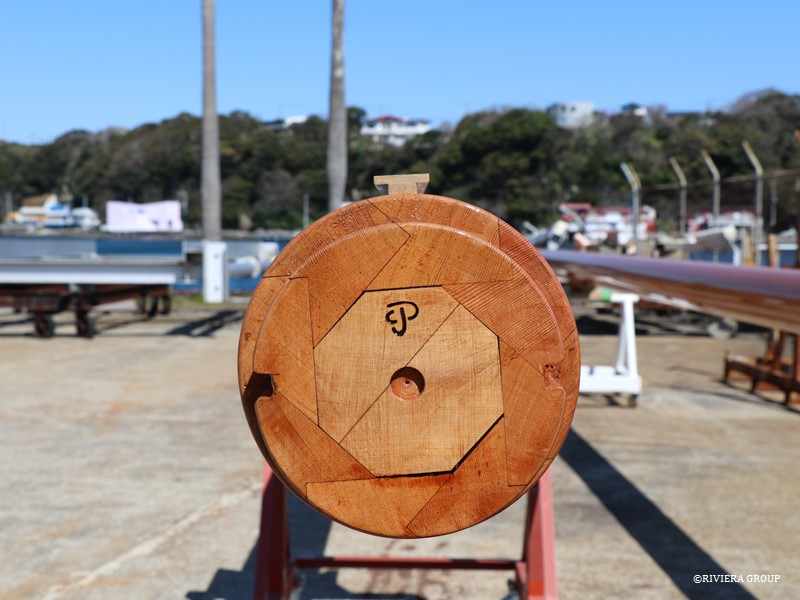
The Rigging
What remained of the original wrought iron fittings was restored. Rather than re-use the various hardware that had been replaced or altered over the years, new parts were built to a common design. A fine balance between the advances in modern materials, the unavailability of older stock and the human resources capable of producing a fully functional “old” yacht was achieved using steel works fabricated in Spain, bronze castings produced in Italy and England, and a full complement of blocks and tackles made by traditional parts manufacturing company in Faversham, U.K.
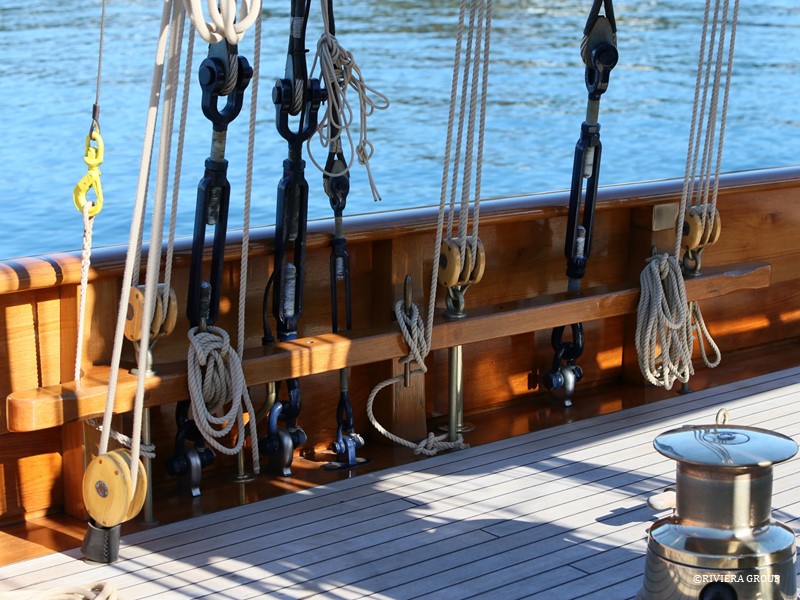

The Sails
The choice of traditional sail makers capable of making a suit of sails to the high standard required of a restoration such as Cynara were few. The final decision by the restoration team was to go to sail loft, the original sail makers of her first suit of sails in 1926. The results have proven once more that quality and experience are what is necessary to provide a suit of sails in keeping with the restoration standards that we required.
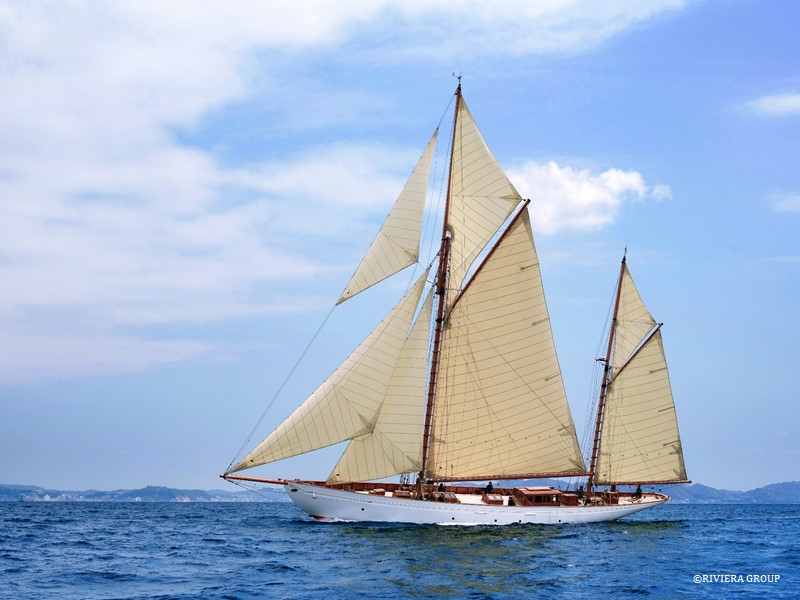
Systems and Engineering
Obviously, it is in the many systems and engineering areas where most technological changes have taken place since Cynara’s launch in 1927. Take, for example, the original engine, which was a Kelvin C4 60 BHP gasoline-powered unit with two 95 gallon fuel tanks, one on each side in the engine room. The current engine is a Yanmar diesel. The fuel tanks are now underfloor in the main bilge, with two hot water tanks in the engine room where the fuel tanks were.
What was once a greasy engine room with a chaotic mess of pipes and cables is now clean and bright with much more space. Also gone is the slippery, oily wooden floor, replaced with an aluminum plate surface, along with modern fire- and sound-proofing that insulates the rest of the yacht from the noisy engine room. During dismantling, we also discovered that the original lead water pipes were still in use, so those were replaced with copper alloys and toughened plastic piping.
Air conditioning units were squeezed into the available space in each cabin. We converted the original bilge vents to become air outlets so the system is invisible in most of the cabins.
All of this was done with great attention to detail, to create a clean, bright interior that offers the comfort and conveniences of the twenty-first-century while maintaining the historic look and feel of this vintage yacht.
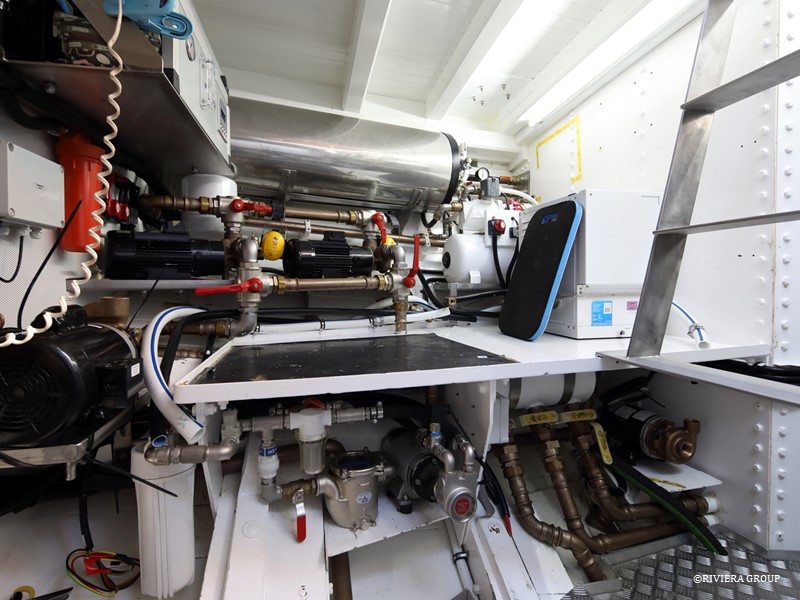
Text and photographs copyright © 2019
RIVIERA CO., LTD. All rights reserved.
Email : pr@riviera.co.jp

